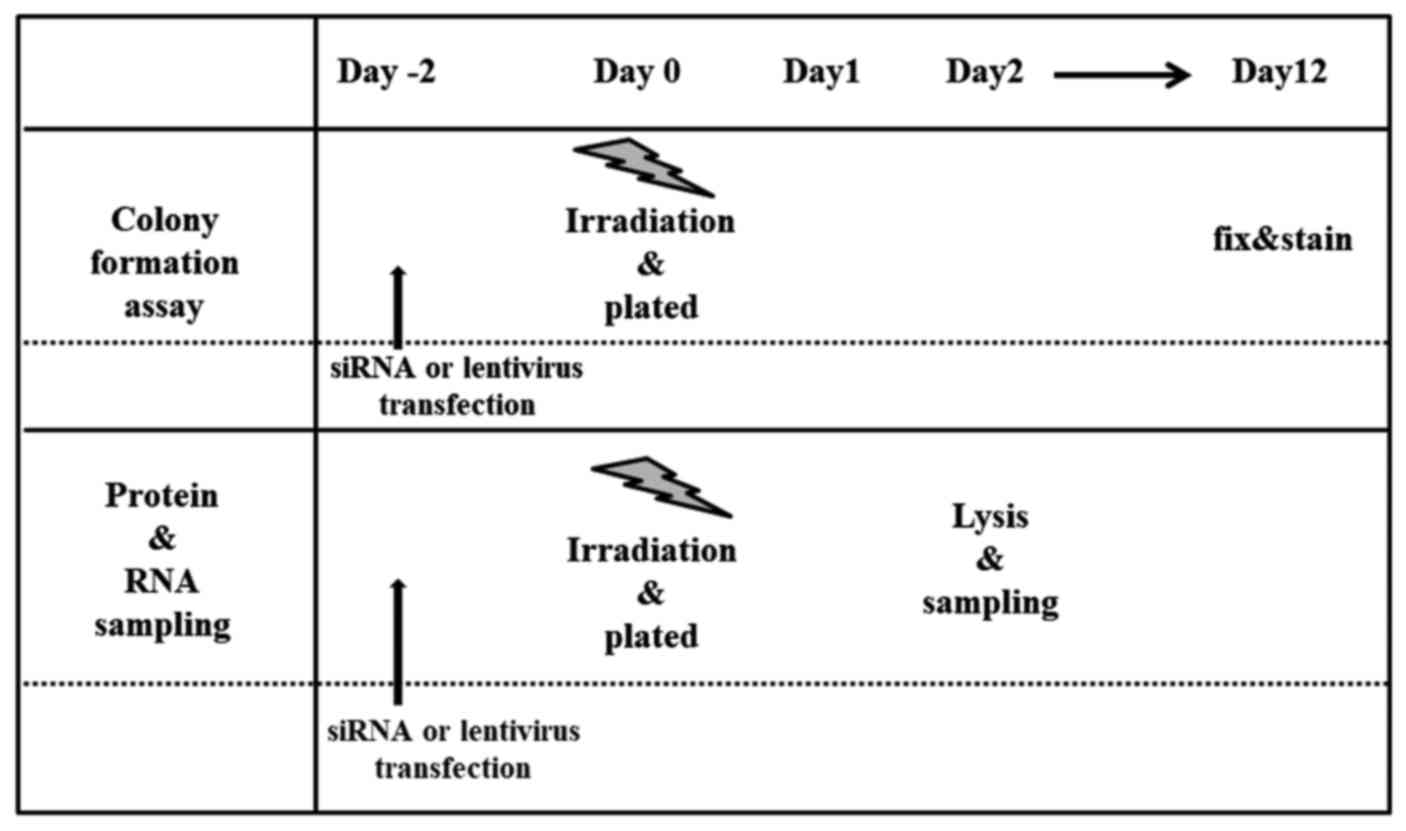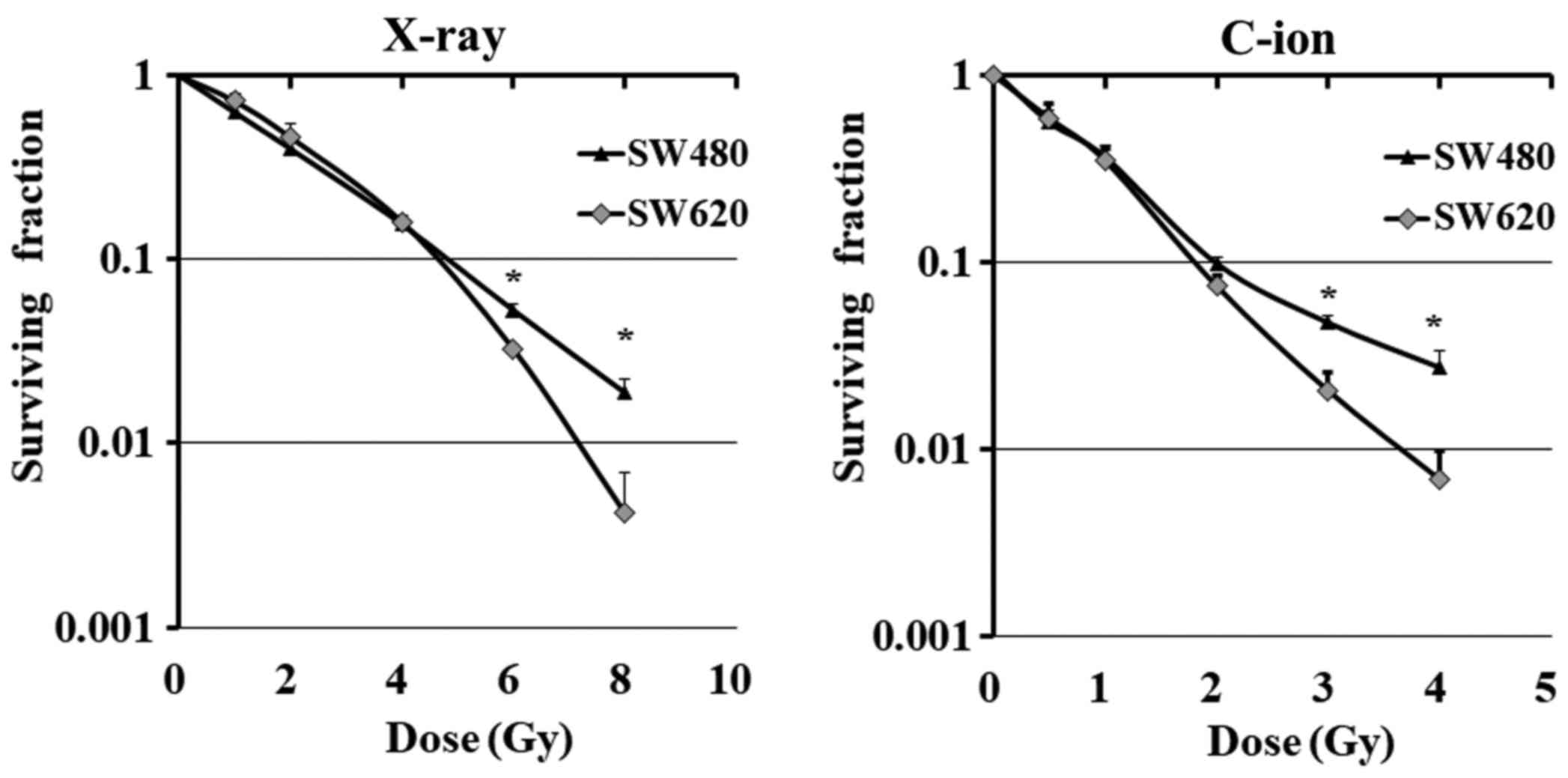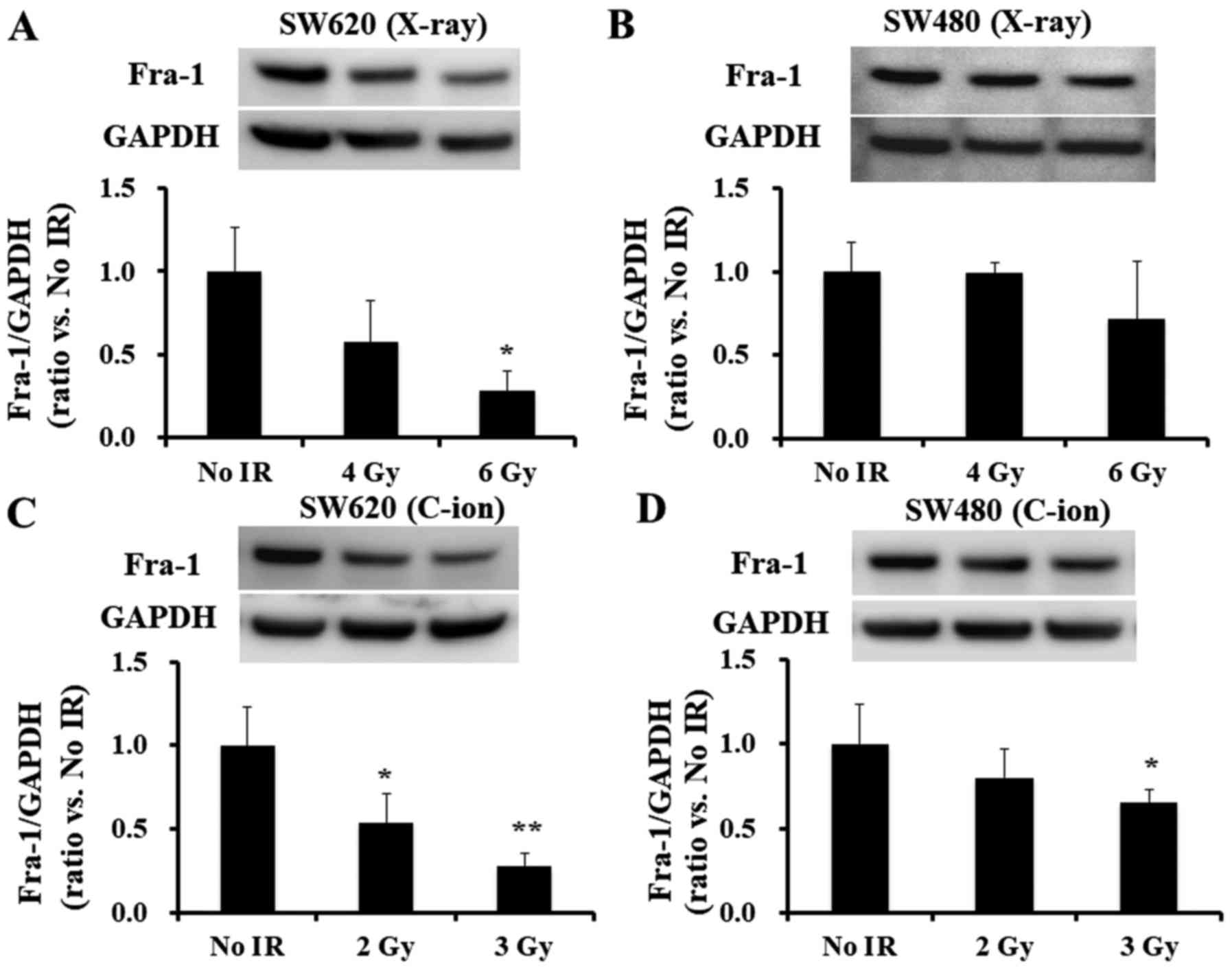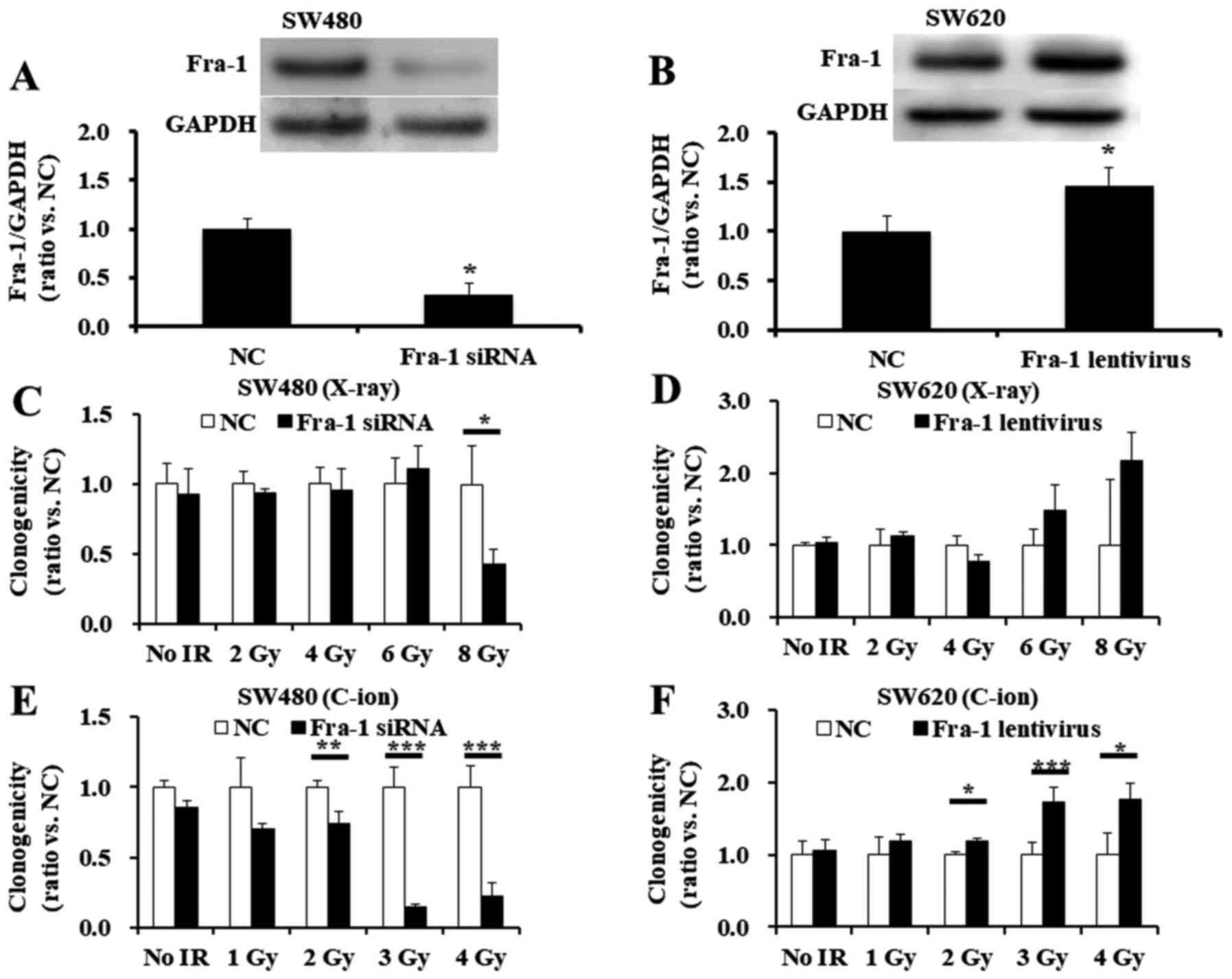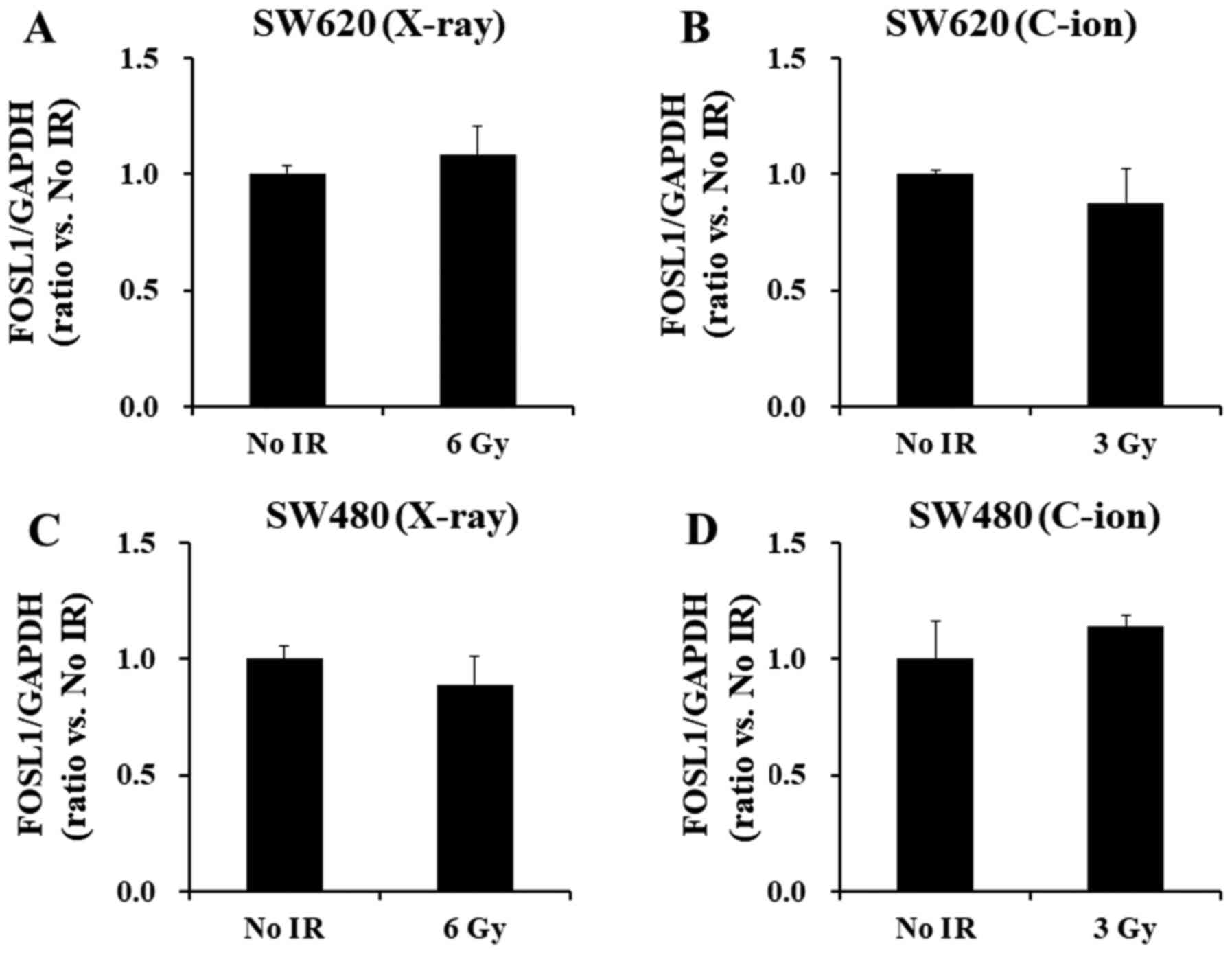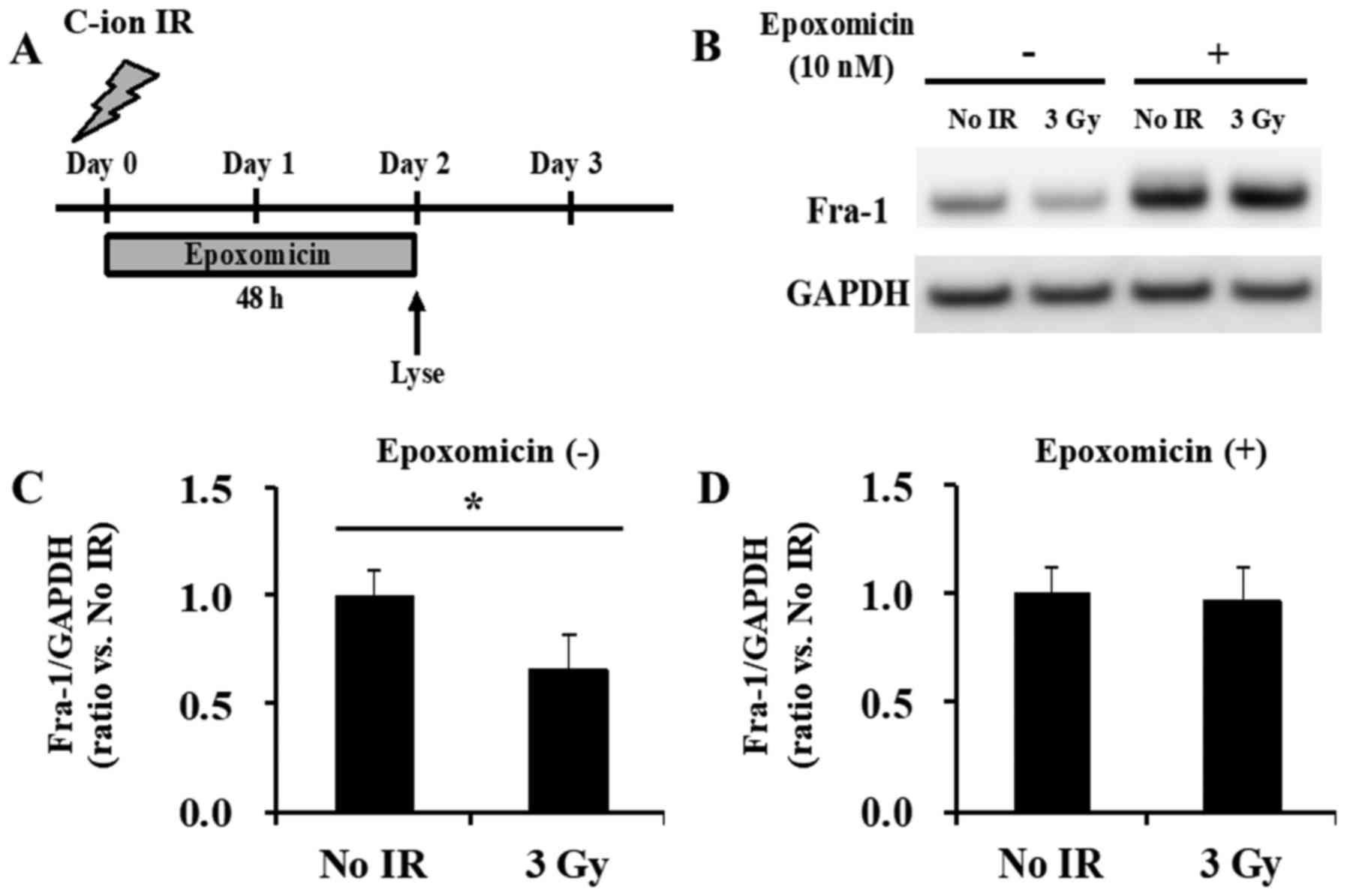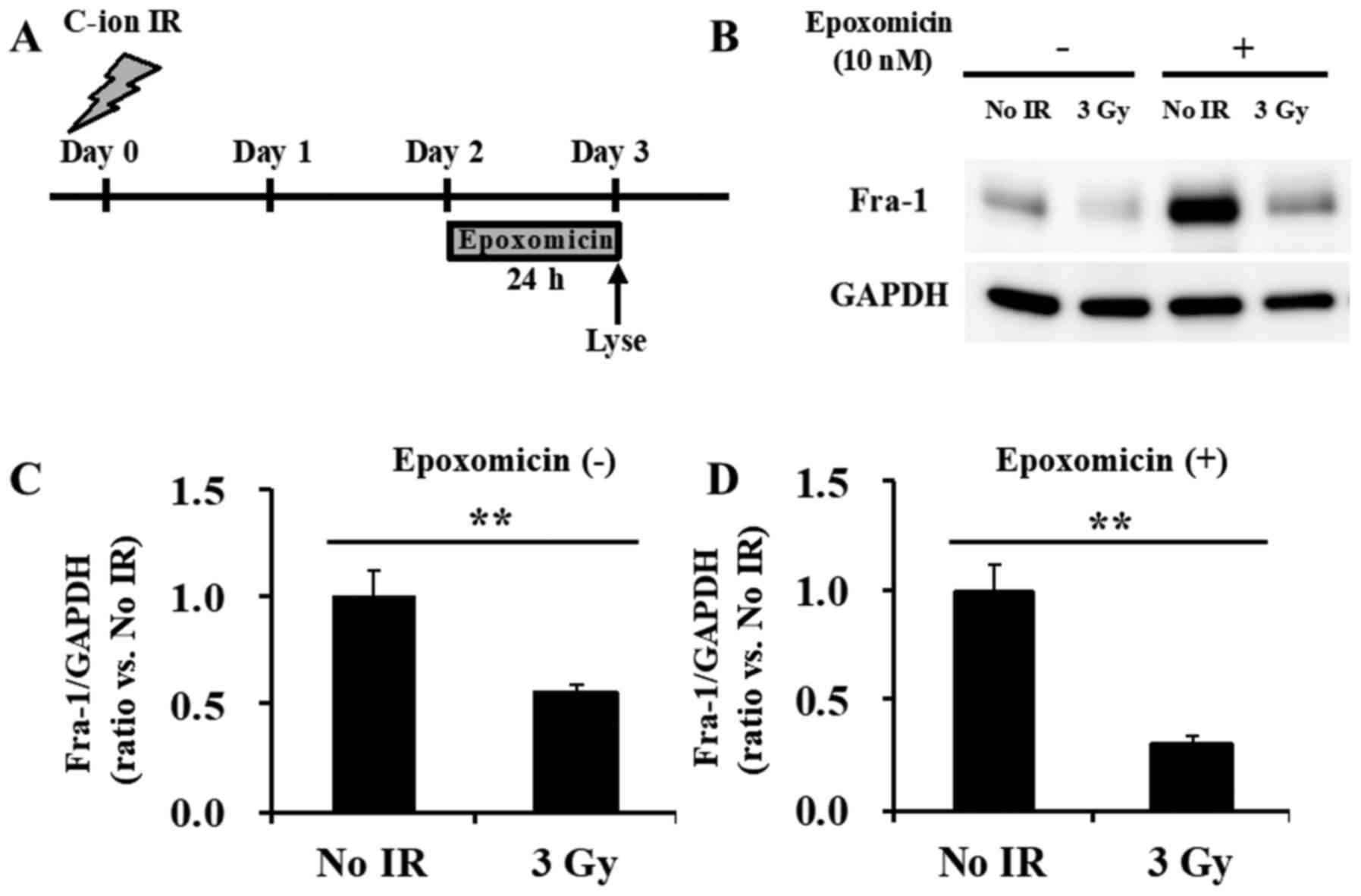Fra‑1 enhances the radioresistance of colon cancer cells to X‑ray or C‑ion radiation
- Authors:
- Published online on: January 19, 2018 https://doi.org/10.3892/or.2018.6223
- Pages: 1112-1118
-
Copyright: © Endo et al. This is an open access article distributed under the terms of Creative Commons Attribution License.
Abstract
Introduction
Fos-related antigen 1 (Fra-1) protein forms activator protein-1 complexes in association with members of the JUN family, which drives the expression of genes involved in various biological processes, including cell proliferation, differentiation, transformation, and invasiveness, in several cancer cell lines (1–3). Fra-1 is usually absent in normal epithelial cells but is upregulated in various cancers, such as lung, breast, colon, prostate, brain, head and neck, esophagus, ovary, and nasopharynx cancers (3–13). Increased Fra-1 expression has been shown to be correlated with tumor stage in esophageal squamous cell carcinoma (8), and high levels of Fra-1 expression are associated with severe malignancy in breast cancer progression (13); thus, Fra-1 is recognized as a prognostic factor for certain cancers (2,8).
Colorectal cancer is currently the most common gastrointestinal malignancy, and it remains the third most common cancer and second leading cause of cancer-related death in developed countries (14). Although surgical resection is the first choice of treatment for colorectal cancer, radiation therapy and chemotherapy are also essential interventions in colorectal cancer treatment. In addition, many patients with local recurrences are not eligible for surgical resection, and they are frequently referred for radiotherapy. However, the results of conventional photon radiotherapy are still far from satisfactory, with many studies in the literature reporting a 50% 1-year survival rate and a 10% 3-year survival rate (15). Thus, the role of photon radiotherapy is often described as mere pain control (16). Carbon-ion (C-ion) beam therapy is well known for its high linear energy transfer (LET), and it has some unique advantages over photon irradiation, including more accurate dose distribution (17–19), a high rate of double-strand breaks of the DNA chain (20,21), and high relative biologic effectiveness of tumor cell killing (22–24). Thus, C-ion radiotherapy is expected to become a promising alternative to surgery for colorectal cancer treatment. Previous research has shown that C-ion radiotherapy may be a safe and effective treatment option for locally recurrent rectal cancer and may serve as an alternative to surgery (25–31).
The radiation dose required for tumor control varies widely among human tumors and depends on a range of factors, such as inherent cellular radiosensitivity, repair and repopulation phenomena, and tumor hypoxia (32–34). Since resistance to radiation is one of the reasons for treatment failure, the identification of key factors involved in cancer radioresistance is important for developing an effective method of chemoradiotherapy. A previous study reported that downregulation of Fra-1 reduced the radioresistance of a prostate cancer cell line, PC-3, after treatment with 4-Gy photon beam irradiation (35). However, there are no published studies of the role of Fra-1 in radioresistance to X-ray or C-ion radiation for colorectal cancer cells.
Herein, we used two human colon cancer cell lines, SW620 and SW480, and demonstrated that Fra-1 has a role in the radioresistance to both X-ray and C-ion radiation.
Materials and methods
Cell culture and reagents
Cells of the human colon cancer cell lines SW620 and SW480 were purchased from ATCC (Manassas, VA, USA) and cultured in Dulbecco's modified Eagle's medium (DMEM; Nissui, Tokyo, Japan) supplemented with 10% fetal bovine serum (FBS; HyClone, Logan, UT, USA), and penicillin/streptomycin (Gibco, Carlsbad, CA, USA).
Irradiation
Cells were irradiated with X-rays or C-ions at room temperature. X-rays were produced by a PANTAK HF-320S generator (Shimadzu Corp., Kyoto, Japan), at 200 kVp and 20 mA, and filtered with 0.5 mm Al and 0.5 mm Cu (36). C-ions were accelerated by the Heavy-Ion Medical Accelerator in Chiba at the National Institute of Radiological Sciences, Chiba, Japan (37). The initial energy of the C-ion beams was 290 MeV/nucleon, and the LET value was 80 keV/µm with a monoenergetic beam (20). An outline of the experimental procedures after irradiation is shown in Fig. 1.
siRNA transfection
The cells were transiently transfected with siRNA specific for Fra-1 using Lipofectamine 2000 Reagent (Invitrogen, Carlsbad, CA, USA), as previously described (8). The sequences of the Fra-1 siRNA were as follows: Sense, agaaaucugggcugcagcgagagau, and antisense, aucucucgcug cagcccagauuucu. Fra-1 protein expression was evaluated by western blotting, and Fra-1 downregulation was confirmed at 48 h after siRNA transfection by comparison with the Fra-1 expression level of the cells transfected with scrambled negative control siRNA (Invitrogen).
Lentivirus production and transduction
The coding sequence of the human FRA1 gene was amplified from cDNA derived from SW480 cells by PCR using a gene-specific primer set: Sense, ggggacaagtttgtacaaaaaagcaggcttcaccatgttccgagacttcggggaacccggcccg, and antisense, ggggaccactttgtacaagaaagctgggtctcacaaagcgaggagggttggagagccaag. The PCR fragment was introduced into a pDONR221 vector for cloning of the gene, in accordance with the instructions for Gateway Cloning Technology (Invitrogen), and confirmed by sequencing. Then, this gene was transferred by LR recombination from its entry clone into a pLenti7.3V5-DEST vector containing Emerald Green Fluorescent Protein (EmGFP). pLenti7.3/V5-GW/lacZ was the construct for the negative control. Lentiviral stocks were produced in 293FT cells in accordance with a modification of the manufacturer's protocol (Invitrogen). Briefly, 18 µl of FuGENE 6 was diluted in 0.6 ml of Opti-MEM I medium, and then 1.5 µg of plasmid DNA and 4.5 µg of packaging mix (Applied Biological Materials Inc., Richmond, BC, Canada) were added to this medium. These transfection complexes were incubated at room temperature and added to 5 ml of Opti-MEM I containing 6×106 cells. After incubation at 37°C for 8 h, the culture medium was replaced with 5 ml of DMEM supplemented with 10% heat-inactivated FBS. Virus-containing supernatants were harvested 48 h after transfection and then centrifuged at 3,000 rpm at 4°C for 15 min and passed through a 0.45-µm Millex-HV filter to remove debris. The virus was precipitated at 4°C overnight by adding 3.3 ml of cold 40% PEG6000, to concentrate the virus, and then suspended in 100 µl of phosphate-buffered saline (PBS). Then, 1×105 cells were transduced by 10 µl of the virus preparation in the presence of 6 µg/ml hexadimethrine bromide (Polybrene) for 48 h. Fra-1 protein expression was evaluated by western blotting, and upregulation of Fra-1 was confirmed at 48 h after lentivirus transfection by comparison with the Fra-1 expression level of the cells transfected with the negative control.
Colony formation assay
Cell survival curves were determined by a colony formation assay as previously described, with some modifications (38). Briefly, cell cultures at 70% confluence were rinsed with PBS and detached with 0.1% trypsin/PBS. Cell numbers were determined with a hemocytometer. Cells were plated in triplicate onto 60-mm diameter plastic dishes and incubated for 12 days, whereupon the colonies were fixed and stained with 1% methylene blue in 30% methanol. Colonies consisting of more than 50 cells were scored as surviving colonies.
For the radiosensitivity analysis, non-irradiated cells or cells irradiated with X-rays at 1, 2, 4, 6, or 8 Gy or C-ions at 0.5, 1, 2, 3, or 4 Gy were used. The cells were trypsinized and counted immediately after irradiation. Eighty cells for non-irradiated cells or 150, 300, 1,500, or 3,000 cells for X-ray irradiation at 1, 2, 4, 6, or 8 Gy or C-ion irradiation at 0.5, 1, 2, 3, or 4 Gy were plated onto 60-mm diameter dishes, respectively. The surviving fraction was normalized to that of the non-irradiated control.
To assess the clonogenicity of the Fra-1 siRNA-transfected or lentivirus-transfected cells, cells were treated with siRNA or lentivirus vector for 48 h before irradiation. Immediately after irradiation, the cells were trypsinized, and the same numbers of cells as that used in the radiosensitivity analysis were plated onto dishes containing fresh media; colony-forming assays were then performed.
Protein sampling and western blotting
Non-irradiated or irradiated cells were trypsinized and counted immediately after irradiation, and the same number of non-irradiated and irradiated cells was plated onto dishes containing fresh media. Two days after irradiation, cells were lysed with RIPA lysis buffer containing PMSF and sodium orthovanadate (Santa Cruz Biotechnology, Dalla, TX, USA) and then used for the western blotting.
For the proteasome inhibitor treatment, two patterns of schedule were used: 1) 10 nM of epoxomicin (proteasome inhibitor; Peptide Institute Inc., Osaka, Japan) was added to the culture media immediately before cell irradiation, and the cells were cultured for 48 h in a 5% CO2 incubator at 37°C and then lysed, or 2) 10 nM of epoxomicin was added to the culture media 48 h after irradiation, and the cells were cultured in a 5% CO2 incubator at 37°C for 24 h. The cells were then lysed with RIPA lysis buffer and used for the western blotting.
Immunoblotting was performed as previously described (37). Primary antibodies for human Fra-1 (Santa Cruz Biotechnology) and GAPDH (Trevigen, Bristol, UK) with horseradish peroxidase-conjugated anti-mouse IgG or anti-rabbit IgG (Amersham Biosciences, Buckinghamshire, UK) were used for this study. Protein bands were detected by enhanced chemiluminescence and imaged using a Lumino image analyzer (LAS4000; Fujifilm, Tokyo, Japan).
Quantitative real-time PCR
Quantitative real-time PCR (qRT-PCR) was performed on a LightCycler 480 with Probes Master (Roche Diagnostics, Basel, Switzerland) as previously described (38). The Universal Probe Library (UPL; Roche Diagnostics) probes and primer sequences for the Fra-1 (FOSL1) and GAPDH genes were as follows: FOSL1 (UPL probe: 26) sense, aggaactgaccgacttcctg, and antisense, cagctctaggcgctccttc; GAPDH (UPL probe: 60) sense, agccacatcgctcagaca, and antisense, gcccaatacgaccaaatcc.
Statistical analysis
Statistical analyses were performed using unpaired Student's t-tests or Mann-Whitney U-tests. P-values of <0.05 was considered to indicate a statistically significant difference.
Results
Role of Fra-1 in radioresistance
Surviving fractions of SW620 and SW480 cells were determined after X-ray or C-ion irradiation. Sensitivity to X-ray or C-ion irradiation differed between the cell lines; SW620 showed lower surviving fractions than SW480 at doses greater than 6 Gy for X-ray or 3 Gy for C-ion radiation (Fig. 2). Of note, SW620 cells showed a greater decrease in Fra-1 after 6 Gy for X-ray or 3 Gy for C-ion irradiation than SW480 cells (Fig. 3A and B for X-ray and Fig. 3C and D for C-ion irradiation, respectively).
To investigate a possible association between Fra-1 downregulation and cellular radiosensitivity, we first treated SW480 cells with Fra-1 siRNA. The effectiveness of Fra-1 reduction with siRNA transfection is shown in Fig. 4A. Downregulation of Fra-1 in siRNA-treated SW480 cells showed increased radiosensitivity to 8-Gy X-ray radiation (Fig. 4C) and to 2-, 3-, or 4-Gy C-ion radiation (Fig. 4E), compared with that of the scrambled negative control-treated SW480 cells.
To further clarify the significance of Fra-1 in radioresistance, we next overexpressed Fra-1 in SW620 cells via transfection with a lentivirus vector. Fra-1 induction with lentivirus transfection is shown in Fig. 4B. Further, overexpression of Fra-1 in lentivirus-transfected SW620 cells tended to increase the resistance to X-ray radiation (Fig. 4D) and significantly enhanced the resistance to C-ion radiation at doses greater than 2 Gy (Fig. 4F). Overall, the results indicate that Fra-1 has some role in radioresistance to X-ray or C-ion radiation for SW480 and SW620 cells.
Fra-1 levels in irradiated SW620 cells were downregulated by protein degradation through a proteasome pathway
To identify the molecular mechanisms modulating Fra-1 levels after irradiation, we first compared the changes of Fra-1 protein and the corresponding FOSL1 transcript levels in SW620 and SW480 cells after X-ray or C-ion irradiation. Although Fra-1 protein levels significantly decreased after irradiation with 6-Gy X-ray or 3-Gy C-ion radiation (Fig. 5A-D), no alteration in the Fra-1 transcript, FOSL1, levels was found for either the SW620 (Fig. 5A and B) or the SW480 cell lines (Fig. 5C and D), which indicates discrepancies between the reduction of Fra-1 protein and transcript levels in the irradiated cells.
The expression of Fra-1 protein is known to be highly regulated by proteasomal degradation (39). To clarify whether proteasomal degradation was involved in the reduction of the Fra-1 protein levels observed in the irradiated cells, C-ion-irradiated SW620 cells were further studied, because a clear discrepancy between the Fra-1 protein and transcript levels was observed in these cells (Figs. 3C and 5B). Pre-treatment of SW620 cells with the proteasome inhibitor epoxomicin and continued treatment for another 48 h after irradiation (Fig. 6A) blocked the Fra-1 degradation of these irradiated cells compared with that of the non-epoxomicin-treated SW620 cells (Fig. 6B-D). Of note, epoxomicin treatment from 48 h after C-ion irradiation (Fig. 7A) failed to block the reduction of Fra-1 (Fig. 7B-D), which indicates that the degradation of Fra-1 via the proteasome occurred at some time during the first 48 h after irradiation.
Discussion
An understanding of the molecular mechanisms involved in radioresistance is necessary for improving the clinical outcomes of cancer radiotherapy. In this study, we demonstrated that Fra-1 has a significant role in the radioresistance of two colorectal cancer cell lines, SW620 and SW480. It is well known that irradiation, especially high LET radiation such as C-ion irradiation, induces cell cycle delay at the G2 phase, arresting the cells at the G2 checkpoint for DNA repair and/or committing them to undergo apoptosis (40). Cyclin A, an important factor for the initiation of DNA replication, is known as a transcriptional target of Fra-1 (41). Thus, greater reduction of Fra-1 may interrupt DNA repair, which could induce cell death.
Fra-1 is known to be involved in various biological processes (1,2). In order to avoid the potential pathological effects of Fra-1 overexpression, the stability of the Fra-1 protein is highly regulated by phosphorylation-dependent proteasomal degradation (39). Thus, Fra-1 is usually absent in normal epithelial cells, but it is upregulated in several cancers (2). Several studies have suggested that the stability of the Fra-1 protein is regulated by phosphorylation upon ERK-MAPK pathway activation (39,42–44). The upstream signaling effectors, such as proteins encoded by oncogenic KRAS, found in colon carcinoma cell lines have been shown to result in constitutive ERK activation, followed by Fra-1 accumulation (38). To clarify whether Fra-1 phosphorylation status is involved in the Fra-1 degradation of irradiated cells, we also determined whether irradiation reduced the phospho-Fra-1 (p-Fra-1) levels in SW620 cells, as Fra-1 de-phosphorylation causes Fra-1 to become unstable and be degraded via the proteasome. Treatment of irradiated SW620 cells with epoxomicin for 48 h upon irradiation clearly blocked the downregulation of Fra-1 (Fig. 6); therefore, we hypothesized that the remaining undegraded Fra-1 contained many of the dephosphorylated Fra-1 proteins, which were destined to be degraded via the proteasome but remained because we had blocked this proteasome function. However, the levels of p-Fra-1 in the epoxomicin-treated SW620 cells were unchanged even after irradiation; the remaining undegraded Fra-1 following epoxomicin treatment did not contain dephosphorylated Fra-1 proteins, and most of them were phosphorylated Fra-1 (data not shown). These results indicate that the dephosphorylation of Fra-1 is not the trigger of proteasomal degradation upon irradiation. We also intended to check the levels of ubiquitinated Fra-1, but we could not detect the ubiquitination of Fra-1 protein (data not shown). Thus far, we have not yet discovered how irradiation leads to Fra-1 degradation via the proteasome, without the involvement of dephosphorylation or ubiquitination of Fra-1, and further studies are required to solve this question.
In conclusion, we found that Fra-1 has a role in the radioresistance to X-ray or C-ion irradiation. To our knowledge, this is the first study indicating the role of Fra-1 in the radioresistance of colorectal cancer cells. In addition, we observed Fra-1 degradation within 48 h after irradiation. It would be of interest to further study whether Fra-1 level could be a candidate as an early response marker to reflect the effectiveness of radiotherapy.
Acknowledgements
This work was supported in part by JSPS KAKENHI grant no. 22591394 for TI and grant no. 23791467 for MF from the Japan Society for the Promotion of Science. We thank Yoshimi Shoji for technical assistance. We would like to thank Enago (www.enago.jp) for the English language review.
Competing interests
The authors declare that they have no competing interests.
Glossary
Abbreviations
Abbreviations:
|
Fra-1 |
Fos-related antigen 1 |
|
C-ion |
carbon ion |
|
RBE |
relative biologic effectiveness |
|
HRP |
horseradish peroxidase |
References
|
Eferl R and Wagner EF: AP-1: A double-edged sword in tumorigenesis. Nat Rev Cancer. 3:859–868. 2003. View Article : Google Scholar : PubMed/NCBI | |
|
Young MR and Colburn NH: Fra-1 a target for cancer prevention or intervention. Gene. 379:1–11. 2006. View Article : Google Scholar : PubMed/NCBI | |
|
Hu YC, Lam KY, Law S, Wong J and Srivastava G: Identification of differentially expressed genes in esophageal squamous cell carcinoma (ESCC) by cDNA expression array: Overexpression of Fra-1, Neogenin, Id-1, and CDC25B genes in ESCC. Clin Cancer Res. 7:2213–2221. 2001.PubMed/NCBI | |
|
Ramos-Nino ME, Scapoli L, Martinelli M, Land S and Moss-man BT: Microarray analysis and RNA silencing link fra-1 to cd44 and c-met expression in mesothelioma. Cancer Res. 63:3539–3545. 2003.PubMed/NCBI | |
|
Hapke S, Kessler H, Luber B, Benge A, Hutzler P, Höfler H, Schmitt M and Reuning U: Ovarian cancer cell proliferation and motility is induced by engagement of integrin alpha(v)beta3/Vitronectin interaction. Biol Chem. 384:1073–1083. 2003. View Article : Google Scholar : PubMed/NCBI | |
|
Kustikova O, Kramerov D, Grigorian M, Berezin V, Bock E, Lukanidin E and Tulchinsky E: Fra-1 induces morphological transformation and increases in vitro invasiveness and motility of epithelioid adenocarcinoma cells. Mol Cell Biol. 18:7095–7105. 1998. View Article : Google Scholar : PubMed/NCBI | |
|
Diesch J, Sanij E, Gilan O, Love C, Tran H, Fleming NI, Ellul J, Amalia M, Haviv I, Pearson RB, et al: Widespread FRA1-dependent control of mesenchymal transdifferentiation programs in colorectal cancer cells. PLoS One. 9:e889502014. View Article : Google Scholar : PubMed/NCBI | |
|
Usui A, Hoshino I, Akutsu Y, Sakata H, Nishimori T, Murakami K, Kano M, Shuto K and Matsubara H: The molecular role of Fra-1 and its prognostic significance in human esophageal squamous cell carcinoma. Cancer. 118:3387–3396. 2012. View Article : Google Scholar : PubMed/NCBI | |
|
Zhang W, Hart J, McLeod HL and Wang HL: Differential expression of the AP-1 transcription factor family members in human colorectal epithelial and neuroendocrine neoplasms. Am J Clin Pathol. 124:11–19. 2005. View Article : Google Scholar : PubMed/NCBI | |
|
Zerbini LF, Wang Y, Cho JY and Libermann TA: Constitutive activation of nuclear factor kappaB p50/p65 and Fra-1 and JunD is essential for deregulated interleukin 6 expression in prostate cancer. Cancer Res. 63:2206–2215. 2003.PubMed/NCBI | |
|
Mann B, Gelos M, Siedow A, Hanski ML, Gratchev A, Ilyas M, Bodmer WF, Moyer MP, Riecken EO, Buhr HJ and Hanski C: Target genes of beta-catenin-T cell-factor/lymphoid-enhancer-factor signaling in human colorectal carcinomas. Proc Natl Acad Sci USA. 96:pp. 1603–1608. 1999; View Article : Google Scholar : PubMed/NCBI | |
|
Fung LF, Lo AK, Yuen PW, Liu Y, Wang XH and Tsao SW: Differential gene expression in nasopharyngeal carcinoma cells. Life Sci. 67:923–936. 2000. View Article : Google Scholar : PubMed/NCBI | |
|
Belguise K, Kersual N, Galtier F and Chalbos D: FRA-1 expression level regulates proliferation and invasiveness of breast cancer cells. Oncogene. 24:1434–1444. 2005. View Article : Google Scholar : PubMed/NCBI | |
|
Siegel RL, Miller KD and Jemal A: Cancer statistics, 2017. CA Cancer J Clin. 67:7–30. 2017. View Article : Google Scholar : PubMed/NCBI | |
|
Yamada S, Shinoto M, Endo S, Yasuda S, Imada H, Kamada T and Tsujii H: Carbon ion radiotherapy for patients with locally recurrent cancer. Proceedings of NIRS-IMP Joint Symposium on Carbon Ion Therapy and Radiation Emergency Med. 1–47. 2012. | |
|
Lingareddy V, Ahmad NR and Mohiuddin M: Palliative reirradiation for recurrent rectal cancer. Int J Radiat Oncol Biol Phys. 38:785–790. 1997. View Article : Google Scholar : PubMed/NCBI | |
|
Tsuji H and Kamada T: A review of update clinical results of carbon ion radiotherapy. Jpan J Clin Oncol. 42:670–685. 2012. View Article : Google Scholar | |
|
Fokas E, Kraft G, An H and Engenhart-Cabillic R: Ion beam radiobiology and cancer: Time to update ourselves. Biochim Biophys Acta. 1796:216–229. 2009.PubMed/NCBI | |
|
Schulz-Ertner D and Tsujii H: Particle radiation therapy using proton and heavier ion beams. J Clin Oncol. 25:953–964. 2007. View Article : Google Scholar : PubMed/NCBI | |
|
Tsuchida Y, Tsuboi K, Ohyama H, Ohno T, Nose T and Ando K: Cell death induced by high-linear-energy transfer carbon beams in human glioblastoma cell lines. Brain Tumor Pathol. 15:71–76. 1998. View Article : Google Scholar : PubMed/NCBI | |
|
Nakano T, Suzuki Y, Ohno T, Kato S, Suzuki M, Morita S, Sato S, Oka K and Tsujii H: Carbon beam therapy overcomes the radiation resistance of uterine cervical cancer originating from hypoxia. Clin Cancer Res. 12:2185–2190. 2006. View Article : Google Scholar : PubMed/NCBI | |
|
Suzuki M, Kase Y, Yamaguchi H, Kanai T and Ando K: Relative biological effectiveness for cell-killing effect on various human cell lines irradiated with heavy-ion medical accelerator in Chiba (HIMAC) carbon-ion beams. Int J Radiat Oncol Biol Phys. 48:241–250. 2000. View Article : Google Scholar : PubMed/NCBI | |
|
Tobias CA, Blakely EA, Alpen EL, Castro JR, Ainsworth EJ, Curtis SB, Ngo FQ, Rodriguez A, Roots RJ, Tenfordf T and Yang TC: Molecular and cellular radiobiology of heavy ions. Int J Radiat Oncol Biol Phys. 8:2109–2120. 1982. View Article : Google Scholar : PubMed/NCBI | |
|
Allen C, Borak TB, Tsujii H and Nickoloff JA: Heavy charged particle radiobiology: Using enhanced biological effectiveness and improved beam focusing to advance cancer therapy. Mutat Res. 711:150–157. 2011. View Article : Google Scholar : PubMed/NCBI | |
|
Yamada S, Kamada T, Ebner DK, Shinoto M, Terashima K, Isozaki Y, Yasuda S, Makishima H, Tsuji H, Tsujii H, et al: Carbon-ion radiation therapy for pelvic recurrence of rectal cancer. Int J Radiat Oncol Biol Phys. 96:93–101. 2016. View Article : Google Scholar : PubMed/NCBI | |
|
Combs SE, Kieser M, Habermehl D, Weitz J, Jäger D, Fossati P, Orrechia R, Engenhart-Cabillic R, Pötter R, Dosanjh M, et al: Phase I/II trial evaluating carbon ion radiotherapy for the treatment of recurrent rectal cancer: The PANDORA-01 trial. BMC Cancer. 12:1372012. View Article : Google Scholar : PubMed/NCBI | |
|
Matsuzaki H, Ishihara S, Kawai K, Nishikawa T, Tanaka T, Kiyomatsu T, Hata K, Nozawa H, Yamada S and Watanabe T: Late sacral recurrence of rectal cancer treated by heavy ion radiotherapy: A case report. Surg Case Rep. 2:1092016. View Article : Google Scholar : PubMed/NCBI | |
|
Yamada S, Shinoto M, Shigeo Y, Imada H, Kato H, Kamada T and Tsujii H: Current status and perspective of heavy ion beam therapy for patients with pelvic recurrence after primarily resected rectal cancer. Gan To Kagaku Ryoho. 36:1263–1266. 2009.(In Japanese). PubMed/NCBI | |
|
Mobaraki A, Ohno T, Yamada S, Sakurai H and Nakano T: Cost-effectiveness of carbon ion radiation therapy for locally recurrent rectal cancer. Cancer Sci. 101:1834–1839. 2010. View Article : Google Scholar : PubMed/NCBI | |
|
Habermehl D, Wagner M, Ellerbrock M, Büchler MW, Jäkel O, Debus J and Combs SE: Reirradiation using carbon ions in patients with locally recurrent rectal cancer at HIT: First results. Ann Surg Oncol. 22:2068–2074. 2015. View Article : Google Scholar : PubMed/NCBI | |
|
Isozaki Y, Yamada S, Kawashiro S, Yasuda S, Okada N, Ebner D, Tsuji H, Kamada T and Matsubara H: Carbon-ion radiotherapy for isolated para-aortic lymph node recurrence from colorectal cancer. J Surg Oncol. 116:932–938. 2017. View Article : Google Scholar : PubMed/NCBI | |
|
Peters LJ, Brock WA, Chapman JD and Wilson G: Predictive assays of tumor radiocurability. Am J Clin Oncol. 11:275–287. 1988. View Article : Google Scholar : PubMed/NCBI | |
|
West CM: Invited review: Intrinsic radiosensitivity as a predictor of patient response to radiotherapy. Br J Radiol. 68:827–837. 1995. View Article : Google Scholar : PubMed/NCBI | |
|
Ishikawa K, Koyama-Saegusa K, Otsuka Y, Ishikawa A, Kawai S, Yasuda K, Suga T, Michikawa Y, Suzuki M, Iwakawa M and Imai T: Gene expression profile changes correlating with radioresistance in human cell lines. Int J Radiat Oncol Biol Phys. 65:234–245. 2006. View Article : Google Scholar : PubMed/NCBI | |
|
Kajanne R, Miettinen P, Tenhunen M and Leppä S: Transcription factor AP-1 promotes growth and radioresistance in prostate cancer cells. Int J Oncol. 35:1175–1182. 2009.PubMed/NCBI | |
|
Fujita M, Otsuka Y, Yamada S, Iwakawa M and Imai T: X-ray irradiation and Rho-kinase inhibitor additively induce invasiveness of the cells of the pancreatic cancer line, MIAPaCa-2, which exhibits mesenchymal and amoeboid motility. Cancer Sci. 102:792–798. 2011. View Article : Google Scholar : PubMed/NCBI | |
|
Fujita M, Imadome K, Shoji Y, Isozaki T, Endo S, Yamada S and Imai T: Carbon-ion irradiation suppresses migration and invasiveness of human pancreatic carcinoma cells MIAPaCa-2 via Rac1 and RhoA degradation. Int J Radiat Oncol Biol Phys. 93:173–180. 2015. View Article : Google Scholar : PubMed/NCBI | |
|
Fujita M, Otsuka Y, Imadome K, Endo S, Yamada S and Imai T: Carbon-ion radiation enhances migration ability and invasiveness of the pancreatic cancer cell, PANC-1, in vitro. Cancer Sci. 103:677–683. 2012. View Article : Google Scholar : PubMed/NCBI | |
|
Basbous J, Jariel-Encontre I, Gomard T, Bossis G and Piechaczyk M: Ubiquitin-independent-versus ubiquitin-dependent proteasomal degradation of the c-Fos and Fra-1 transcription factors: Is there a unique answer? Biochimie. 90:296–305. 2008. View Article : Google Scholar : PubMed/NCBI | |
|
Sasaki H, Yatagai F, Kanai T, Furusawa Y, Hanaoka F, Zhu WG and Mehnati P: Dependence of induction of interphase death of Chinese hamster ovary cells exposed to accelerated heavy ions on linear energy transfer. Radiat Res. 148:449–454. 1997. View Article : Google Scholar : PubMed/NCBI | |
|
Casalino L, Bakiri L, Talotta F, Weitzman JB, Fusco A, Yaniv M and Verde P: Fra-1 promotes growth and survival in RAS-transformed thyroid cells by controlling cyclin A transcription. EMBO J. 26:1878–1890. 2007. View Article : Google Scholar : PubMed/NCBI | |
|
Vial E and Marshall CJ: Elevated ERK-MAP kinase activity protects the FOS family member FRA-1 against proteasomal degradation in colon carcinoma cells. J Cell Sci. 116:4957–4963. 2003. View Article : Google Scholar : PubMed/NCBI | |
|
Casalino L, De Cesare D and Verde P: Accumulation of Fra-1 in ras-transformed cells depends on both transcriptional autoregulation and MEK-dependent posttranslational stabilization. Mol Cell Biol. 23:4401–4415. 2003. View Article : Google Scholar : PubMed/NCBI | |
|
Basbous J, Chalbos D, Hipskind R, Jariel-Encontre I and Piechaczyk M: Ubiquitin-independent proteasomal degradation of Fra-1 is antagonized by Erk1/2 pathway-mediated phosphorylation of a unique C-terminal destabilizer. Mol Cell Biol. 27:3936–3950. 2007. View Article : Google Scholar : PubMed/NCBI |



